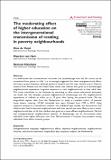Files in this item
The moderating effect of higher education on the intergenerational transmission of residing in poverty neighbourhoods
Item metadata
| dc.contributor.author | de Vuijst, Elise | |
| dc.contributor.author | van Ham, Maarten | |
| dc.contributor.author | Kleinhans, Reinout | |
| dc.date.accessioned | 2017-06-26T11:30:15Z | |
| dc.date.available | 2017-06-26T11:30:15Z | |
| dc.date.issued | 2017-09-01 | |
| dc.identifier | 250335509 | |
| dc.identifier | fa3c1d46-2963-4d29-96ef-690bc1f95584 | |
| dc.identifier | 85027028965 | |
| dc.identifier | 000407469400012 | |
| dc.identifier.citation | de Vuijst , E , van Ham , M & Kleinhans , R 2017 , ' The moderating effect of higher education on the intergenerational transmission of residing in poverty neighbourhoods ' , Environment and Planning A , vol. 49 , no. 9 , pp. 2135-2154 . https://doi.org/10.1177/0308518X17715638 | en |
| dc.identifier.issn | 0308-518X | |
| dc.identifier.other | RIS: urn:454EAC862DB5803DD9A8CDD7EEF40E66 | |
| dc.identifier.other | ORCID: /0000-0002-2106-0702/work/64697578 | |
| dc.identifier.uri | https://hdl.handle.net/10023/11081 | |
| dc.description | The research leading to these results has received funding from the European Research Council under the European Union’s Seventh Framework Programme (FP/2007–2013)/ERC Grant Agreement n. 615159 (ERC Consolidator Grant DEPRIVEDHOODS, Socio-spatial inequality, deprived neighbourhoods, and neighbourhood effects) and from the Marie Curie programme under the European Union’s Seventh Framework Programme (FP/2007–2013)/Career Integration Grant n. PCIG10-GA-2011-303728 (CIG Grant NBHCHOICE, Neighbourhood choice, neighbourhood sorting, and neighbourhood effects). | en |
| dc.description.abstract | It is well-known that socioeconomic outcomes and (dis)advantage over the life course can be transmitted from parent to child. It is increasingly suggested that these intergenerational effects also have a spatial dimension, although empirical research into this topic remains scarce. Previous research from Sweden and the United States shows that children who grow up in disadvantaged neighbourhoods experience long-term exposure to such neighbourhoods in their adult lives. This study contributes to the literature by examining to what extent educational attainment can break the link between parental neighbourhood disadvantage and the neighbourhood experiences of children as adults up to 12 years after leaving the parental home. We use longitudinal register data from the Netherlands to study a complete cohort of parental home leavers, covering 119,167 individuals who were followed from 1999 to 2012. Using sequence analyses as a visualisation method, and multilevel logit models, we demonstrate that children who lived in deprived neighbourhoods with their parents are more likely to live in similar neighbourhoods later in life than children who grew up in more affluent neighbourhoods. We find that intergenerational neighbourhood patterns of disadvantage can be discontinued when individuals attain higher education over time. Discontinuation is however less prevalent among individuals from ethnic minority groups. | |
| dc.format.extent | 20 | |
| dc.format.extent | 446524 | |
| dc.language.iso | eng | |
| dc.relation.ispartof | Environment and Planning A | en |
| dc.subject | Intergenerational inequality | en |
| dc.subject | Neighbourhood effects | en |
| dc.subject | Deprived neighbourhoods | en |
| dc.subject | Neighbourhood histories | en |
| dc.subject | Educational attainment | en |
| dc.subject | Longitudinal data | en |
| dc.subject | Sequence analysis | en |
| dc.subject | The Netherlands | en |
| dc.subject | GF Human ecology. Anthropogeography | en |
| dc.subject | HM Sociology | en |
| dc.subject | LB2300 Higher Education | en |
| dc.subject | NDAS | en |
| dc.subject.lcc | GF | en |
| dc.subject.lcc | HM | en |
| dc.subject.lcc | LB2300 | en |
| dc.title | The moderating effect of higher education on the intergenerational transmission of residing in poverty neighbourhoods | en |
| dc.type | Journal article | en |
| dc.contributor.sponsor | European Research Council | en |
| dc.contributor.institution | University of St Andrews. Geography & Sustainable Development | en |
| dc.identifier.doi | https://doi.org/10.1177/0308518X17715638 | |
| dc.description.status | Peer reviewed | en |
| dc.identifier.grantnumber | ERC-2013-CoG | en |
This item appears in the following Collection(s)
Items in the St Andrews Research Repository are protected by copyright, with all rights reserved, unless otherwise indicated.

